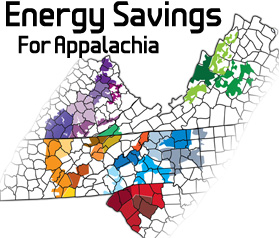Front Porch Blog

The abundant opportunity for greater energy efficiency in our region and the lack of programs to seize it led us to establish our Energy Savings for Appalachia program.
Today’s Bloomberg View editorial bears a headline at once forehead-slapping simple and frustratingly complex: “Energy Efficiency Is Long Overdue.”
I used to read articles like this all the time. Apparently I sometimes still do. But whether it’s “long overdue,” or a “no-brainer,” or the “low-hanging fruit” of economic recovery or development, all the phrases that appear so often in pieces pointing to our untapped potential for energy efficiency can be disheartening when pitted against our energy-inefficient reality.
“On a global scale, we humans are becoming more energy efficient with each passing year,” the Bloomberg piece begins. “Even so, we’re exploiting only a fraction of the technological opportunities to use energy more cost-effectively.” Sure enough, the authors eventually ask, “If energy efficiency is such a no-brainer, why doesn’t it happen faster without government intervention?”
Reading on, the authors point to several shortcomings of the market and our own “irrational short-termism.” Combine the lack of financing options, the information gap between your average homeowner and energy economics, and misplaced resources such as enormous subsidies for fossil fuels and it’s no wonder few have really figured out the supposed no-brainer of energy efficiency.
Consider the Southeast, which has long relied on burning coal for the lion’s share of its electricity generation. The region has 29 percent of the nation’s energy efficiency potential and represents one of the largest opportunities for reducing energy consumption and generating new economic opportunities. The “Saudi Arabia of untapped energy efficiency potential,” it’s been called.
In rural areas of North Carolina, Virginia and Tennessee, the energy consumption rates of millions of homes are up to 25 percent higher than the national average. And rates are trending upward at a rate as high as 2.4 percent per year, while demand and consumption in other parts of the country are decreasing.

Making energy efficiency even more of a no-brainer: The Energy Savings Action Center gives you the tools to promote or take advantage of energy efficiency programs offered through your utility.
It was this potential and the lack of programs to seize it that motivated Appalachian Voices to establish our Energy Savings for Appalachia program, which aims to develop and implement loan programs that will reduce energy demand and enhance economic opportunities in rural areas served by electric membership cooperatives.
One energy savings initiative that the Bloomberg piece proposes, and that we advocates for, is on-bill financing loan programs, described in the editorial as a pleasant-sounding “pay-as-you-save” plan. This type of program lets homeowners or businesses pay for efficiency improvements through a monthly charge on their utility bill that is less than the resulting cut in energy costs — creating a guaranteed net saving.
Currently, only a handful of cooperatives in our region provide ways for their customers to finance efficiency improvements. That could soon change, however, now that the U.S. Department of Agriculture has finalized the Energy Efficiency and Conservation Loan Program, which authorizes the Rural Utilities Service to provide $250 million in low-interest loans to electric cooperatives to develop on-bill financing programs.
Programs to help rural Americans overcome barriers to energy efficiency are proving their worth by saving money and stimulating local energy services companies, supporting jobs that cannot be mechanized or outsourced. Of course, as a welcome byproduct, greater energy efficiency means less air pollution and carbon emissions.
To pluck the low-hanging fruit that is energy efficiency, there must be popular support for state and federal policies, and greater public understanding of the opportunities, however long overdue. That’s where education comes in, and frankly, it’s the biggest no-brainer of them all. With our new Energy Savings Action Center, you can learn about and promote energy efficiency programs through your electric utility and connect with energy services companies in your area. And it’s as easy as entering your zip code.
Check the availability of energy savings programs through your utility using the Energy Savings Action Center and visit the Energy Savings for Appalachia program’s homepage to learn more about the benefits of energy efficiency.
PREVIOUS
NEXT
Related News

Leave a comment
Your email address will not be published. Required fields are marked *

Thanks for the comment, Barry. That’s what I was trying to get at in the post — despite ample opportunity, we need action and tangible programs like the USDA’s as well as education to help people overcome the information gap. The New York schools example is perfect and one that resonates with me. I learned about the importance of recycling as a child when a man dressed as an aluminum can came and danced through the hallways and anthropomorphized bottles and plastics were made into an educational cartoon. We should pursue both, giving adults the resources they need and giving children the knowledge that we already have.
While methods and tips to save energy or to be energy efficient are plenty, the question is ”How many are actually practicing these?” To make sure that people become more involved in these programs in New York school kids are given training to be energy efficient. The latest method is installing and <a href="http://www.newyorkenergyinsider.com/general-category/new-york-school-sees-the-light-with-energy-efficient-upgrade/"distributing energy efficient lights. This reduces carbon emission as well.
The advantage of schools promoting these kinds of programs is that kids tend to follow these kind of practices more than elders. And they can change their parents mindset also. So let us see what changes these young tots will bring in energy saving methods.